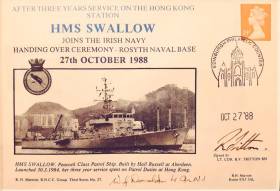Displaying items by tag: 30 yrs INS career
Former Hong Kong 'Peacock' Pair Pass 30 Years of Operations With Irish Naval Service
#NavalService - A pair of Peacock class UK Royal Navy patrol vessels that had been based in Hong Kong, were handed over to the Irish Naval Service 30 years ago, writes Jehan Ashmore.
The pair LÉ Orla (video) the former HMS Swift (P243) and sister LÉ Ciara, ex HMS Swallow (P243) built by Hall Russell & Co (no longer in business) Scotland were commissioned for the Royal Navy. They patrolled the waters of the British colony that would itself be handed over to China in 1997.
The sleek profile pair built in 1984/5 were part of an order for five coastal patrol vessels (CPV) on station at Hong Kong. They were specifically built to serve in the RN's Hong Kong Patrol Squadron, however the pair only served three years before been brought by the Irish Government at a price considered to be a bargain, given they were almost new.
Apparently, there was friction over the acquisition of the CPV's, between the RN and the UK Government, as the navy did not have enough such vessels of this size operating in homewaters.
It was also then rumoured the reasoning for the transfer of the CPV's to the Irish Government was due to the ongoing troubles in Northern Ireland and that of security concerns. At the time, the UK prime minister was Margaret Thatcher, leader of the Conservative Party.
The handover ceremony of the CPV's between the UK and Irish navies took place on 27 October 1988 and aptly took place back at their birthplace in Scotland, albeit at the Rosyth Naval Base on the Firth of Forth.
Following the delivery voyage of the CPV's from Scotland, it was during the following month, that an impromptu invite arose to visit the Irish Naval Service base in Cork Harbour.
Moored abreast in the Naval Base basin was LÉ Orla and LÉ Ciara. Boarding took place that led to a busy scene as crew and contractors prepared the ships into the fleet, which increased to 7 patrol ships. Among them the Irish built flagship of the Irish Naval Service, the HPV LÉ Eithne, likewise the same age of the CPV's.
On the visit, at that stage the CPV's had already been given the new names, albeit unofficially the pair had not been commissioned into service. The LÉ Orla and LÉ Ciara proudly reflecting Irish mythological women's names given to the navy vessels, a tradition that (until more recent years) stretched to the foundation of the Irish Naval Service in 1946.
The Taoiseach, C.J. Haughey of Fianna Fail, in January 1989 paid a visit to the CPV's to commission the secondhand tonnage into service at the Naval Base on Haulbowline Island, itself a former Royal Naval Base in lower Cork Harbour.
Each of the CPV displacing 712 tons, have a crew compliment of 39 personnel (5 officers). The main armament is a 76mm OTO Melara Canon using a Radamec Fire Control System. As for propulsion plant, this is a Crossley SEMT- Pielstick Diesels delivering 14,400hp through two shafts and a speed of 25 knots plus.
Due to their high speed, the pair's shallow draught (2.7m) made these vessels ideal for patrolling close to the rugged coastlines notably on the western seaboard. During the CPV's careers, they have been involved in some of the largest seizures of arms and narcotics in the history of this State.
According to the Defence Forces website, a notable operation of LÉ Orla took place in 1993 when the CPV conducted the biggest drug seizure in the history of the state at the time. This involved the interception and boarding at sea of the 65ft ketch, Brime.
As for LÉ Ciara, the small ship scored a notable operational success as in 1999, the CPV conducted the second biggest drug seizure in the history of the state at that time. The incident saw an interception and boarding at sea of MV Posidonia of the south-west coast.
The pair however as Afloat reported in 2015 were out of commission for several months due to airborne asbestos being discovered in the engine rooms but all such dangerous material was removed. Also reported that year, the sisters during normal refit work at Cork Dockyard, underwent remedial work done on the funnels, cranes and air-handling units.





























































